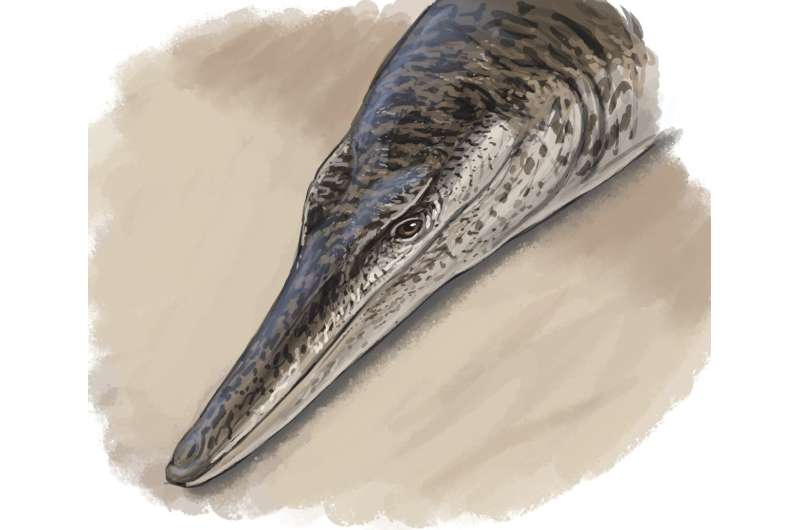
Reconstruction of the life of Enalietes by Joschua Knüppe. Credit: Joschua Knüppe
An international team of scientists, including researchers from Germany and the UK, has described a new species of ancient saltwater crocodile, Enalioetes schroederi. Enalioetes lived in the shallow seas that covered much of Germany during the Cretaceous period, about 135 million years ago.
This ancient crocodile was a member of the family Metriorhynchidae, a remarkable group that evolved a body plan similar to that of dolphins. Metriorhynchidae had smooth, scaleless skin, flippers, and a tail fin. They fed on a variety of prey, including fast-moving animals like squid and fish, but some Metriorhynchidae species had large, serrated teeth, suggesting they fed on other marine reptiles. Metriorhynchidae are best known from the Jurassic period, with fossils becoming rarer in the Cretaceous. Enalioetes schroederi is known from a three-dimensional skull, making it the best-preserved Metriorhynchidae known from the Cretaceous.
Sven Sachs, from the Naturkunde-Museum Bielefeld and the project leader, said: “This specimen is remarkable because it is one of the few metriorhynchs whose skull is preserved in three dimensions. This allowed us to scan the specimen and learn a lot about the internal anatomy of these saltwater crocodiles. This remarkable preservation allowed us to reconstruct the internal cavities and even the inner ears of the animal.”
Dr Mark Young, from the University of Edinburgh’s School of Geosciences, said: “Enalioetes gives us new insight into the evolution of metriorhynchids during the Cretaceous period. During the Jurassic, metriorhynchids developed a radically different body plan to other crocodiles: flippers, a tail fin, loss of bony armour and smooth skin without scales. These changes were adaptations to an increasingly marine lifestyle. Enalioetes shows us that this trend continued into the Cretaceous, as Enalioetes had even larger eyes than other metriorhynchids (which were already large by crocodilian standards) and the bony inner ears were even more compact than those of other metriorhynchids, indicating that Enalioetes was probably a faster swimmer.”
The perfectly preserved skull and the first cervical vertebrae were discovered over a hundred years ago by the German government architect D. Hapke in a quarry in Sachsenhagen, near Hanover. The specimen has an interesting history. It was given for preparation and study to Henry Schroeder of the Prussian Geological Survey in Berlin, where it was probably incorporated into the collection. This led to the assumption that the specimen had been lost during the Second World War. Later, the specimen was rediscovered in the Minden Museum in West Germany. It turned out that the specimen had been returned to its finder, whose family had brought it to Minden, where they found a new home after the Second World War, taking the specimen with them. The crocodile has since been one of the most valuable specimens in the Minden collection.
Henry Schroeder of the Geological Survey of Berlin provided the initial description and the species is named after him.
By comparing the fossil with those in other museum collections, Sachs and his team determined that it was a species new to science.
More information:
Sven Sachs et al, A new genus of metriorhynchid crocodylomorph from the Lower Cretaceous of Germany, Journal of Systematic Paleontology (2024). DOI: 10.1080/14772019.2024.2359946
Provided by the University of Edinburgh
Quote:135-million-year-old marine crocodile sheds light on Cretaceous life (2024, August 9) retrieved August 10, 2024 from https://phys.org/news/2024-08-million-year-marine-crocodile-cretaceous.html
This document is subject to copyright. Apart from any fair dealing for the purpose of private study or research, no part may be reproduced without written permission. The content is provided for informational purposes only.



